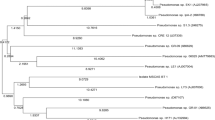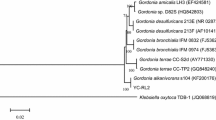Abstract
In this study, a bacterial strain P13 capable of degrading pendimethalin was isolated from the soil of a fruit garden. Based on observed cellular morphology and physiology characteristics and a phylogenetic analysis of 16S rRNA gene sequences, strain P13 was identified as a member of the genus Paracoccus. Strain P13 grew on pendimethalin as the sole carbon source, and could degrade 100 mg/L pendimethalin within 2 days and 200 mg/L pendimethalin within 5 days. Pendimethalin degradation was proposed to be initiated by oxidation ring cleavage to yield 1,3-dinitro-2-(pentan-3-ylamino)butane-1,4-diol, an alkane organic compound that was identified by ultra-high performance liquid chromatography coupled to tandem mass spectrometry (UHPLC–MS/MS), which then underwent a series of enzymatic reactions to produce CO2 and H2O. The optimal pH and temperature for pendimethalin degradation by strain P13 were 7.0 and 30 °C, respectively. This study identified the bacterial strain Paracoccus sp. P13, which degraded pendimethalin with a relatively high efficiency, and presents a previously unreported microbial pendimethalin degradation pathway.





Similar content being viewed by others
References
Das N, Ray S, Jena S, Mohanty P (1998) Effect of certain herbicides on weeds and population of root-knot nematode (Meloidogyne incognita) in mustard. Crop Res 16:156–158
Elsayed B, El-Nady MF (2013) Bioremediation of pendimethalin-contaminated soil. Afr J Microbiol Res 7(21):2574–2588
Fliedner A (1997) Ecotoxicity of poorly water-soluble substances. Chemosphere 35:295–305
Huang X, Zhang H, Chen F, Song M (2018) Colonization of Paracoccus sp. QCT6 and enhancement of metribuzin degradation in maize rhizosphere soil. Curr Microbiol 75(2):156–162
Jia KZ, Cui ZL, He J, Guo P, Li SP (2006) Isolation and characterization of a denitrifying monocrotophos-degrading Paracoccus sp. M-1. FEMS Microbiol Lett 263(2):155–162
Ju KS, Parales RE (2010) Nitroaromatic compounds, from synthesis to biodegradation. Microbiol Mol Biol Rev 74(2):250–272
Kole RK, Saha J, Pal S, Chaudhuri S, Chowdhury A (1994) Bacterial degradation of the herbicide pendimethalin and activity evaluation of its metabolites. Bull Environ Contam Toxicol 52:779–786
Kulshrestha G, Singh SB, Lal SP, Yaduraju NT (2000) Effect of long-term field application of pendimethalin: enhanced degradation in soil. Pest Manag Sci 56:202–206
Ma JY, Wang SF, Wang PW, Ma LJ, Chen XL, Xu RF (2006) Toxicity assessment of 40 herbicides to the green alga Raphidocelis subcapitata. Ecotoxicol Environ Safe 63:456–462
Megadi VB, Tallur PN, Hoskeri RS, Mulla SI, Ninnekar HZ (2010) Biodegradation of pendimethalin by Bacillus circulans. Indian J Biotechnol 9:173–177
More VS, Tallur PN, Niyonzima FN, More SS (2015) Enhanced degradation of pendimethalin by immobilized cells of Bacillus lehensis XJU. 3 Biotech 5(6):967–974
Ni HY, Yao L, Li N, Cao Q, Dai C, Zhang J, He Q, He J (2016) Biodegradation of pendimethalin by Bacillus subtilis Y3. J Environ Sci 41:121–127
Nie ZJ, Hang BJ, Cai S, Xie XT, He J, Li SP (2011) Degradation of cyhalofop-butyl (Cyb) by Pseudomonas azotoformans strain qdz-1 and cloning of a novel gene encoding cyb-hydrolyzing esterase. J Agric Food Chem 59(11):6040–6046
Pinto A, Serrano C, Pires T, Mestrinho E, Dias L, Teixeira DM, Caldeira A (2012) Degradation of terbuthylazine, difenoconazole and pendimethalin pesticides by selected fungi cultures. Sci Total Environ 435:402–410
Ramakrishna M, Mohan SV, Shailaja S, Narashima R, Sarma PN (2008) Identification of metabolites during biodegradation of pendimethalin in bioslurry reactor. J Hazard Mater 151:658–661
Richardson ML, Gangolli SE (eds) (1994) The dictionary of substances and their effects, vol 6. The Royal Society of Chemistry, Clays Ltd., Cambridge, pp 431–432
Ritter L, Solomon K, Forget J, Stemeroff M, O’Leary C (1995) Persistent organic pollutants: an assessment report on DDT. Aldrin, dieldrin, endrin, chlordane, heptachlor, hexachlorobenzene, mirex, toxaphene, polychlorinated biphenyls, dioxins, and furans. International Programme on Chemical Safety (IPCS)
Roca E, D’Errico E, Izzo A, Strumia S, Esposito A, Fiorentino A (2009) In vitro saprotrophic basidiomycetes tolerance to pendimethalin. Int Biodeterior Biodegrad 63:182–186
Sharef IB, Abdelbagi A, Elsheikh EA, Ahmed AES, Elsaid OEG (2013) Biodegradation of pendimethalin by three strains of bacteria isolated from pesticide-polluted soils. U K J Agric Sci 21(2):233–252
Strandberg M, Scott-Fordsmand JJ (2004) Effects of pendimethalin at lower trophic levels—a review. Ecotoxicol Environ Safe 57:190–201
Tomlin C (1997) Pesticide manual, 11th edn. British Crop Protection Council, Farnham, ISBN 1-901396-11-8
Venkata Mohan S, Rama Krishna M, Muralikrishna P, Shailaja S, Sarma P (2007) Solid phase bioremediation of pendimethalin in contaminated soil and evaluation of leaching potential. Bioresour Technol 98(15):2905–2910
Wauchope RD, Buttler T, Hornsby A, Augustijn-Beckers P, Burt J (1992) The SCS/ARS/CES pesticide properties database for environmental decision-making. Springer, New York, pp 1–155
Younes M, Galal-Gorchev H (2000) Pesticides in drinking water—a case study. Food Chem Toxicol 38:S87–S90
Zhang C, Hughes JB, Nishino SF, Spain JC (2000) Slurry-phase biological treatment of 2,4-dinitrotoluene and 2,6-dinitrotoluene: role of bioaugmentation and effects of high dinitrotoluene concentrations. Environ Sci Technol 34:2810–2816
Zhang J, Yin JG, Hang BJ, Cai S, He J, Zhou SG, Li SP (2012) Cloning of a novel arylamidase gene from Paracoccus sp. strain FLN-7 that hydrolyzes amide pesticides. Appl Environ Microbiol 78(14):4848–4855
Acknowledgements
This work was financially supported by the National Natural Science Foundation of China (31760031 and 31600080), the Natural Science Foundation of Jiangxi Province (20171BAB214002), and the Natural Science Foundation of Shandong Province (ZR2016CB29).
Author information
Authors and Affiliations
Corresponding authors
Additional information
Haiyan Ni and Na Li contributed equally to this work.
Electronic supplementary material
Below is the link to the electronic supplementary material.
Rights and permissions
About this article
Cite this article
Ni, H., Li, N., Qiu, J. et al. Biodegradation of Pendimethalin by Paracoccus sp. P13. Curr Microbiol 75, 1077–1083 (2018). https://doi.org/10.1007/s00284-018-1494-0
Received:
Accepted:
Published:
Issue Date:
DOI: https://doi.org/10.1007/s00284-018-1494-0




